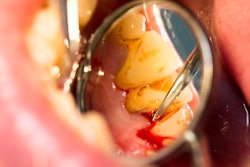
Patients with an average weight paid significantly less for periodontal treatments than those who were obese regardless of disease severity, according to a study published on May 24 in the Journal of the American Dental Association.
Additional gum disease treatment costs that could be attributed to obesity were higher than those attributable to diabetes or smoking. Therefore, body mass index (BMI) can be a critical sign of expected gum disease treatment and its associated costs, the authors wrote.
“Patients who were obese had considerably higher periodontal treatment costs than patients who were normal weight,” wrote the authors, led by Dr. Astha Singhal, MPH, an assistant professor in the department of health policy and health services research at Boston University Henry M. Goldman School of Dental Medicine (JADA, May 23, 2023).
Costly, prevalent disease
About half of adults in the U.S. are affected by periodontal disease. The disease not only affects a person’s quality of life, but it comes with a significant economic burden. Periodontal disease is estimated to account for about $3.5 billion in direct treatment costs and $150 billion in indirect costs due to productivity loss, according to the study.
Though the specific causal relationship between obesity and periodontal disease has not been established, it is believed that carrying extra weight contributes to gum disease through multiple pathways. Some research has shown that average-weight patients may respond better to periodontal treatment than patients who are obese. Consequently, patients who are obese or overweight may require additional, more intensive periodontal treatment, which could lead to higher costs, the authors wrote.
To understand the association between periodontal treatment costs and obesity, the authors conducted a retrospective cohort study using electronic dental records from 3,443 patients who were examined at a U.S. dental school between July 2010 and July 2019. During the study period, the patients had initial periodontal exams and within six months of providing a medical history, had at least one follow-up periodontal examination, had at least two years of follow-up, and had no missing covariates. Of the patients, 39% were average weight (with a BMI of 18.5 to 24.9), 36% were overweight (a BMI of 25 to 29.9), and 25% were obese (a BMI greater than or equal to 30), according to the study.
Compared to patients who were average weight, those who were overweight and obese were older and more likely to have severe periodontal disease, diabetes, and be covered by public dental insurance. Also, those who were obese were more likely to be women and tobacco users than those who were average weight, the authors wrote.
Patients who were obese paid more for periodontal treatments than overweight and average-weight patients. The mean (standard deviation) total treatment costs for those who were obese were $450 ($1,185) compared to $431 ($1,136) for overweight patients and $289 ($761) for those who were average weight.
After adjusting for possible confounding variables, covariates, and periodontal disease status, the differences in total costs among various BMI groups dropped. However, the difference in total costs for periodontal treatment was 27% greater for patients who were obese than for patients who were average weight, even after accounting for all variables, including tobacco use, disease severity, and diabetes, the authors wrote.
One noteworthy finding was that extra costs due to obesity were consistently higher than those for diabetes or smoking for any periodontal disease category. For example, a man with moderate periodontitis would see his periodontal treatment costs increase by $54 if he had diabetes, $72 if he was a smoker, and $78 if he was obese, they wrote.
The study had several limitations, including that patients self-reported their weight and height. When self-reporting, weight can be underreported and height can be overreported, which may result in misclassification, the authors wrote.
Practical implications
Since BMI may indicate the need for greater periodontal treatment, clinicians may find it prudent to encourage patients to maintain a healthy weight. The study may be used to help direct clinical guidelines, as well as dental benefit design and coverage policies, they wrote.
“Periodontal disease might be an obesity-associated condition, such that costlier treatment is needed to resolve the disease among patients who are obese,” Singhal and colleagues wrote.




















